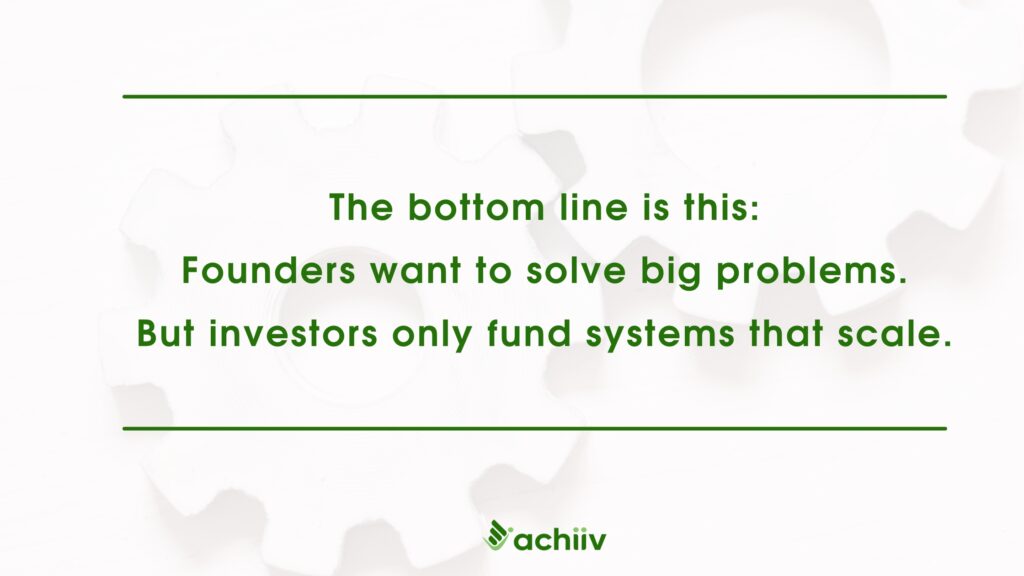Is there a magic ingredient that somehow makes investors want to read your pitch deck and talk to you? I don’t know about that, but I may have found an anti-magic pill that repels them, and can hurt you as a founder before you ever get a shot at pitching.
I was reviewing the pitch deck for a healthcare startup. A switch flipped. The moment I saw the words “Care Collective” on the title slide, my brain, trained by years in the world of finance, instinctively rejected it as a small, soft, service business with no potential for growth and scale.
Except this one wasn’t.
As I overcame my initial hangup and dug in, I found a rich vein of gold inside. By slide three it was clear this was a serious company. An experienced founding team with a compelling business blending smart devices and AI-driven monitoring with proven insurer support and measurable outcomes.
The growth plan was clear. I liked their funding strategy. It was thoughtful and credible. By the end, I was ready to take it to the next step, because I was sold. This was an infrastructure business with lots of upside. What was not to like?
I was forced to confront my own unconscious bias that got triggered the moment I saw some specific types of words. This despite my strong desire to help every type of startup, especially those that don’t get a fair shake in the world of startup funding despite having strong fundamentals.
I was shocked at how easily I had fallen into a stereotype trap.
This made me wonder: how many founders are torching their funding chances before the investor even opens the deck?
And what can they do to fix it?
Understanding Linguistic Bias
At first glance this might feel cosmetic, even trivial. After all, we are in the business of judging by substance, right?
Why Linguistic Bias Happens
In reality, no matter how objective someone is, language is the first filter through which they make snap judgments about a startup.
Because there are so many pitches to get through, investors constantly look for ways to eliminate the majority of the incoming flow. An easy way is probing for key words that don’t signal scale, growth potential. Investors know that startups optimized around software, data, and systems, not those needing huge amounts of human effort, have the best shot at fast growth and high returns.
The result is a subtle but persistent downgrade. A founder who’s built a national reimbursement-enabled infrastructure for chronic care is suddenly treated like a home-care operator.

The startup hasn’t changed. But the language the founder used instantly changed its trajectory and shunted into a side track of slow funding and small rounds.
How It Happens: The Mechanics of Language Coding
Every investor carries an internal dictionary linking words to business models. They use these keywords as cognitive shortcuts to evaluate the entire potential of your startup.
For example:
| Investor keyword | Business translation |
| Platform | Scalable tech system |
| Infrastructure | Defensible market position |
| Network | Monetizable structure |
| Workflow | Integration, stickiness |
| Data | Leverage, IP |
But founders are living in a different universe. They’re completely immersed in their worldview of the problem they are solving and the markets they are serving. So they use words that are attuned to their market context. Words like support, care, community, program.
But here’s the problem:
| Founder says | Investor hears |
| Support | Labor intensive, low margin |
| Care | Not scalable |
| Community | Soft engagement, low revenue |
| Program | Temporary or grant-funded |
| Wellness | Lifestyle, low willingness to pay |
More importantly, many founders unthinkingly use industry and market specific terms that don’t carry any contextual power to investors. For example, words like “midwife services”, “baby care”, or other gender-specific terms and issues.
These words instantly turn off many investors who hear these words as “small”, “niche”, “low growth, low demand”.
When founders describe their businesses in emotionally resonant terms, they activate the wrong circuits in investors’ brains. Instead of “venture scale”, investors hear “lifestyle business.”
More examples:
| Founder Framing | Actual Business | Investor-Aligned Framing |
| Home Nurture Service | Remote monitoring for chronic care | Home-Care Infrastructure Platform |
| Caregiver Collective | Workforce management SaaS for care agencies | Care Workforce Infrastructure |
| Parent Support Network | Employer dependent-care reimbursement system | Dependent-Care Benefits Platform |
| Women’s Wellness Hub | Predictive analytics for chronic disease prevention | Preventive Health Data Platform |
| KindCare | Payment and compliance engine for care providers | Care-Economy FinOps Infrastructure |
Each business on this list has enterprise-level economics. But the founder framing likely kills their prospects versus an investor-oriented frame (right column)
The bottom line is that founders want to solve big problems that matter. But investors only fund systems that scale.
The Impact: Systemic Undervaluation of Specific Types of Startup
When linguistic bias is so pervasive and so invisible, as I myself saw first hand, the effects start to snowball:
-
- False negatives skyrocket: When language codes a business as unscalable, investors unconsciously apply the wrong evaluation lens. A tech infrastructure company that happens to serve a caregiving market gets filtered like a service business. So the company fails investor tests not because it lacks merit, but because it was evaluated through the wrong lens.
- Bias poisons the entire downstream process: Even if the startup passes the first test, unconscious bias from this framing pervades the entire evaluation process: diligence, benchmarking, and market comparisons. Suddenly, the founder’s comps are small regional players, not category-defining platforms. The perceived TAM shrinks. The exit paths look narrower. The language just sidetracked the startup and founder into a much smaller box.
- The vicious cycle repeats: Systemic undercapitalization harms returns which hardens investor bias against these types of startups, perpetuating an enduring cycle of undercapitalization and lost opportunity and returns. This is bad for investors too.
A Simple Fix For Founders
In an ideal world, these issues wouldn’t matter but as founders you have to work in the real world. You can’t change the system but you can have a powerful impact on your own chances if you’re strategic about how you frame your startup to investors.

Highlight the System, Not the Soul
Just because you need to get funding doesn’t mean you have to “sell your soul”. That’s a false dichotomy. You CAN authentically inhabit both worlds by highlighting the core mechanics that will make your mission scale:
- Probe your entire pitching vocabulary for mission-coded words that suggest emotion. For example, “support”, “empower”,”community”. There’s nothing wrong with these words, but if you lead with these when talking to investors, you’ll likely end up paying a huge linguistic penalty
- Identify the mechanism or infrastructure that’s going to help you scale your solution to the problem. For example: network, ecosystem, platform, backend, infrastructure, performance, protocol.
- Then lead your story with the mechanism, not the mission. Investors can feel the mission through your data, not your adjectives.
Move Compassion Into Outcomes
Investors value compassion if it’s expressed through evidence and translates to returns. So reframe your story into objective, hard evidence they can validate: For example:
- “We help families care for loved ones” becomes “We reduce hospital readmissions by 22% through continuous home monitoring.”
- “We support caregivers” becomes “We automate scheduling, payroll, and compliance across 200 large scale agencies.”
- “We nurture patients toward recovery” becomes “We deliver AI-assisted remote care that improves adherence and outcomes.”
Use Language as Leverage
The best mental trick I’ve seen work with founders is to change how you think about the words you use when you pitch. Take every descriptive word in your deck and drop it into a simple two-by-two: scale on one axis, margin on the other.
Now look at where your words sit.
If most of them land in the low-scale, low-margin corner, that’s a clue that your story is probably working against you. If you’re using words like program, community, care or service, they are excellent candidates for reconsideration.
How can you transform your descriptions into power words that suggest systems, scale and durability? When you do this, you win twice in the eyes of investors: you clarify your business model and also redefine your entire category’s worth not just for you but for all your fellow founders doing this work.
Is your mission worth the work?







